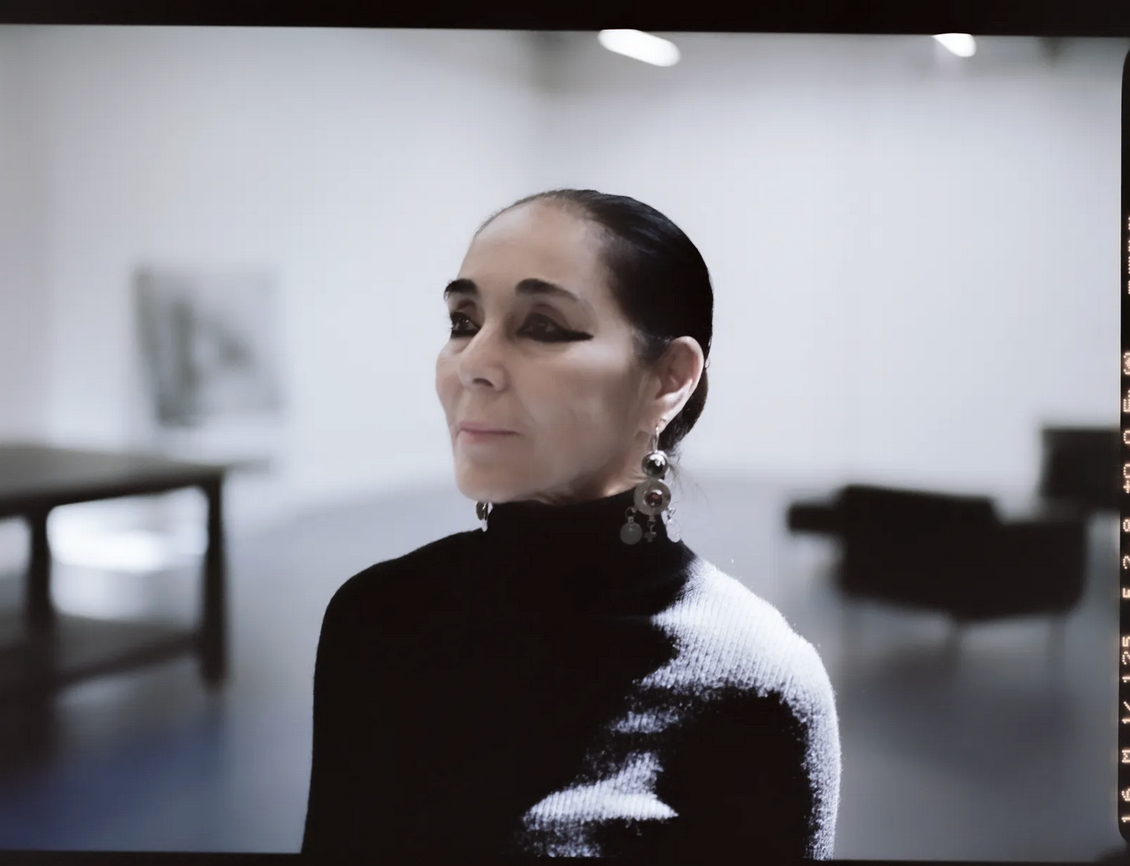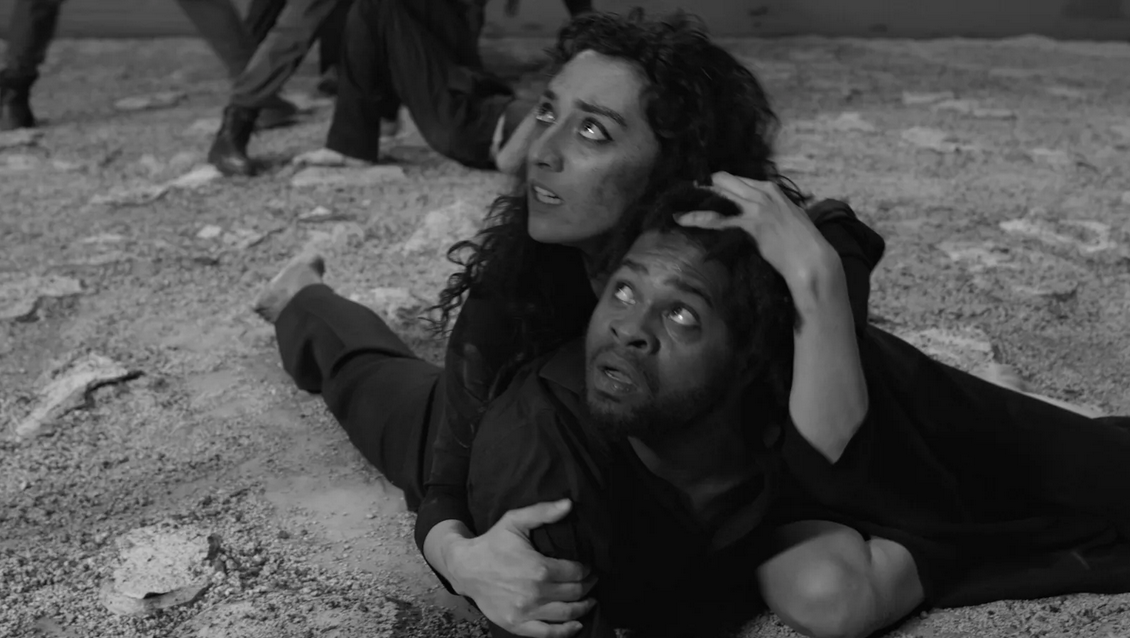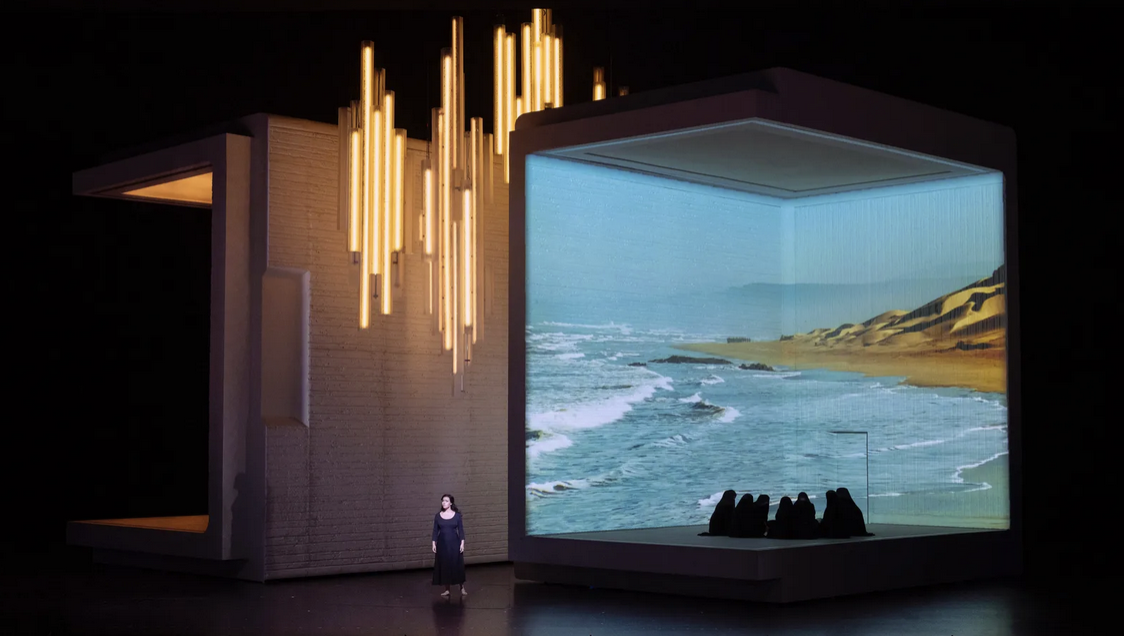VOGUE Arabia : Exclusive: Shirin Neshat Reimagines Aida for a World at War
The legendary Iranian contemporary artist and creative director brings her equalising perspective to the Paris Opera.
Photo: Aida courtesy of the Paris Opera.
Through the windows from inside Café Français in Paris, Shirin Neshat can be seen crossing the Place de la Bastille from the direction of the Opera House. Amid the flow of pedestrians, her lithe frame appears so slight that it’s like a lock of wiry, ebony hair moving through the crowd. While it’s the second day of summer, the mood feels sombre. Just hours ago, news broke that the United States – where Neshat has lived for 41 years – had bombed her country of birth, Iran. She was born in Qazvin, where she lived until the age of 17, before political unrest forced her to move abroad. It is from the US that Neshat built an international name for herself as a groundbreaking video artist, photographer and film director. Her work explores the intersection of women, religion and political identity, and her visual language is poetic and confrontational, offering a deeply human reflection on repression, exile and cultural duality.
Shirin Neshat photographed by Cheryl Dunn.
Neshat’s art transcends borders. It resonates emotionally and intellectually with viewers regardless of religion, gender or ethnicity. Her work has been featured in a retrospective at The Broad in Los Angeles, and has earned numerous accolades, including the International Prize at the Venice Biennale and the Silver Lion for Best Director at the Venice Film Festival for her political drama Women Without Men (2009). This month, she adds yet another title to her list of accomplishments – creative director of Aida for the Paris Opera – a role that promises to merge her distinct visual world with the grandeur and history of one of Europe’s most storied cultural institutions.
Neshat arrives for the interview straight from The Opéra Bastille after a day charged with filming video content for Aida, which is set to premiere on 24 September and run for a month. “I was completely dismantled when I heard the news about Iran. I physically felt ill,” she says, settling on a couch. Ironically, she adds, today’s shoot focused on Aida’s central battle scene. Written by Giuseppe Verdi in 1871 for the Cairo Opera House, Aida tells the story of an Ethiopian princess enslaved in ancient Egypt and an Egyptian military commander caught between his love for her and duty toward his nation. The so-called “triumph” scene, a lavish parade of Egypt’s military victory over Ethiopia, marks the opera’s dramatic climax. Under Neshat’s direction, however, the spectacle has been radically reimagined.“Here, we witness the parallel reality,” she says. “The horror and suffering of the slaves, and then the celebration – the euphoric sense of victory – on the other side. The audience is constantly reminded of both.” The scene, imagined for a 19th-century tragic opera, holds immense relevance to present-day political affairs and current events. “It reminds me of what someone told me recently: in Gaza, people are starving and being bombed relentlessly. Just a few kilometres away, people are playing volleyball on the beach. Can you imagine? This is exactly what we’re talking about. We are all complicit in how we are in denial of the pain that ‘the other’ suffers,” reflects Neshat.
Her intention with this new staging is clear: to strip away the grandeur that glorifies war. “The brutality of Aida, of war and the way the opera has traditionally celebrated horror, genocide and conquest, is wrong,” she says with conviction. Under Neshat’s creative vision, the enslaved characters are no longer decorative and anonymous figures in the background. “Usually, they’re just in the back, as pure victims. Now, much of what I’m filming centres on their experience – their narrative,” she explains. Through haunting videos projected during the performance, Neshat offers the audience a visceral, humanising counter-narrative that refuses to let pain be ornamental.
Neshat was first appointed creative director of Aida in 2022. She recalls a surprising meeting with Markus Hinterhäuser, artistic director of the renowned Salzburg Festival: “I thought he was going to ask me to collaborate with an existing director,” she says. “But instead, he said, ‘I’d like to invite you to direct Aida,’ and I was like, ‘What?’” She emphasises that it is one of the most “epic” and “iconic” operas to date. “Many directors don't like to work with Aida because most of the audience knows it, and the average public really wants that kind of celebration of war. But I think in terms of Hinterhäuser and Salzburg, they wanted to really challenge their audience and find directors who are not from the opera, and who can bring a fresh view to the story.”And yet, for her debut at the Salzburg Festival, Neshat admits that she approached the project with caution. “I worked with perhaps the best conductor and soprano in the world – Riccardo Muti and Anna Netrebko,” she recalls. “And so, I think, I held back. I was really trying to be cautious in terms of how much of my own work and signature I brought into it, in order to give more room to the music and the singers.”
Three years later, following the Paris Opera’s purchase of Aida from Salzburg, Neshat has evolved her vision and the Paris Opera gave her the green light. “I am much more in command of the opera, but also, I’m much closer to who I am, my work and my conceptual and visual strategy,” she asserts.
“I'm a newcomer to the opera world, and I don't have a big agenda or career ambition. The best I can do is be very honest and faithful to what I can bring to the opera, as opposed to being just very respectful to the rules.”
Shirin Neshat
Despite her experience and accolades, Neshat admits that doubt still finds its way in. “If you’re not shaking, you’re not in the right place,” she smiles. “But once I’m there, I find that there's always this reserved confidence or strength that comes through. I honestly believe, and I can only speak from my experience as a woman, especially as an Iranian woman, that there’s a part of us that transcends crisis. Fear eventually dissolves. And many times, when I’ve felt vulnerable or scared, I remind myself: the only way to deal with fear is to face it.”
Neshat pauses for a moment, then adds, “I feel lucky to come from Iran. You learn perspective – about career, art and life. You learn what truly matters: relationships, people and humanity. That’s why this is the right project to make a difference. Because it’s about us. It’s about them. It’s about seeing both.”
Photo: Still by Shirin Neshat for Aida. Courtesy of the Paris Opera.
Her intention with this new staging is clear: to strip away the grandeur that glorifies war. “The brutality of Aida, of war and the way the opera has traditionally celebrated horror, genocide and conquest, is wrong,” she says with conviction. Under Neshat’s creative vision, the enslaved characters are no longer decorative and anonymous figures in the background. “Usually, they’re just in the back, as pure victims. Now, much of what I’m filming centres on their experience – their narrative,” she explains. Through haunting videos projected during the performance, Neshat offers the audience a visceral, humanising counter-narrative that refuses to let pain be ornamental.
Neshat was first appointed creative director of Aida in 2022. She recalls a surprising meeting with Markus Hinterhäuser, artistic director of the renowned Salzburg Festival: “I thought he was going to ask me to collaborate with an existing director,” she says. “But instead, he said, ‘I’d like to invite you to direct Aida,’ and I was like, ‘What?’” She emphasises that it is one of the most “epic” and “iconic” operas to date. “Many directors don't like to work with Aida because most of the audience knows it, and the average public really wants that kind of celebration of war. But I think in terms of Hinterhäuser and Salzburg, they wanted to really challenge their audience and find directors who are not from the opera, and who can bring a fresh view to the story.”And yet, for her debut at the Salzburg Festival, Neshat admits that she approached the project with caution. “I worked with perhaps the best conductor and soprano in the world – Riccardo Muti and Anna Netrebko,” she recalls. “And so, I think, I held back. I was really trying to be cautious in terms of how much of my own work and signature I brought into it, in order to give more room to the music and the singers.”
Photo: Aida courtesy of the Paris Opera.
Three years later, following the Paris Opera’s purchase of Aida from Salzburg, Neshat has evolved her vision and the Paris Opera gave her the green light. “I am much more in command of the opera, but also, I’m much closer to who I am, my work and my conceptual and visual strategy,” she asserts.
“I'm a newcomer to the opera world, and I don't have a big agenda or career ambition. The best I can do is be very honest and faithful to what I can bring to the opera, as opposed to being just very respectful to the rules.”
Shirin Neshat
Despite her experience and accolades, Neshat admits that doubt still finds its way in. “If you’re not shaking, you’re not in the right place,” she smiles. “But once I’m there, I find that there's always this reserved confidence or strength that comes through. I honestly believe, and I can only speak from my experience as a woman, especially as an Iranian woman, that there’s a part of us that transcends crisis. Fear eventually dissolves. And many times, when I’ve felt vulnerable or scared, I remind myself: the only way to deal with fear is to face it.”
Neshat pauses for a moment, then adds, “I feel lucky to come from Iran. You learn perspective – about career, art and life. You learn what truly matters: relationships, people and humanity. That’s why this is the right project to make a difference. Because it’s about us. It’s about them. It’s about seeing both.”
Written by Caterina Lo Mascolo Minthe for https://www.voguearabia.com/





